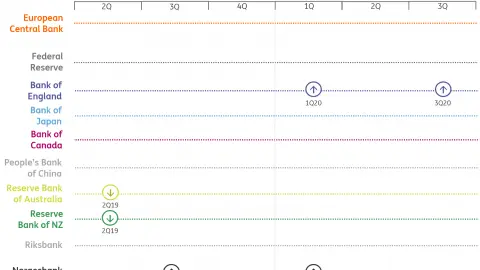Counting the cost of a low carbon economy
Wind and solar power will need a $13 trillion investment over 30 years to reach emissions targets, as demand for power doubles
Key points
- A low carbon global economy would more than double the demand for power, from 27,000 terawatt hours (TWh) to 57,000 TWh.
- Wind and solar energy are key in the energy transition: an estimated $13 trillion of investments in wind and solar are needed to reduce CO2 emissions by 64% in 2050 compared to current levels.
- The potential for private investment is dependent on public investment: additional grid investment is needed to accommodate the increased power demand and volatility of supply.
- Public commitment is needed in terms of spatial planning, smooth permitting procedures and the labour force to install solar and wind projects.
Tech and the transition to a low carbon economy
At the end of 2018, we asked whether technology could provide the answer to climate change. In our report, we presented a ‘Positive Tech' scenario, which was optimistic about the pace of solar and wind energy adoption. In this paper, we calculate the amount of investment needed for a 64% reduction in global energy-related CO2 emissions by 2050.
Although this reduction is in line with the IPCC emissions target for a low carbon economy, it takes time for new technologies to be implemented while the global economy continues to grow. As a result, the 'Positive Tech' scenario is in line with the 2050 targets, but misses the 2030 targets.
The scenario focuses on the substitution of oil, coal and gas for wind and solar energy sources. These are a crucial factor behind the reduction in CO2 emissions. We believe the scenario is realistic as it factors in sensible implementation pathways of new technologies. It also does not include still highly uncertain technologies like nuclear fusion.
Global power demand more than doubles
Energy demand is expected to grow in the coming decades as a result of continuing economic and demographic growth. Electricity consumption is expected to grow even faster because of the search for new technologies that do not need fossil fuels and can therefore reduce emissions. This is likely to happen in the major energy intensive sectors, for example:
- In manufacturing: through increased recycling rates using electric instead of fossil-based processes, for instance in steel. Furthermore, using electricity instead of gas for steam production and the production of hydrogen;
- In real estate: through an increased use of electrical appliances, space cooling and heat pumps and - specifically in developing countries - substitution of bioenergy (burning wood for heating and cooking) for electricity;
- In transport: further uptake of electric vehicles, which could lead to global sales being fully electric by 2040, with almost the entire fleet making the switch by 2050. Furthermore, the electric truck is expected to gain substantial market share in the next decade. This applies to electric ships as well, but to a lesser extent.
As a result, power demand increases from around 27,000 TWh currently to 57,000 TWh by 2050 in ING’s Positive Tech scenario. To put this in perspective, power demand in 2040 is 9,000 TWh higher in our scenario compared to the well-known Sustainable Development scenario from the International Energy Agency, which has a planning horizon to 2040 instead of 2050.
38,000 TWh of wind and solar power generated in 2050
Currently, fossil fuels account for two-thirds of the global power mix. In ING’s 'Positive Tech' scenario, wind and solar would provide two-thirds of electricity. They would each account for half of the total of 38,000 TWh that is needed in 2050, so 19,000 TWh. Current levels for solar and wind are 600 TWh and 1,500 TWh, respectively.
Solar needs more capacity than wind
Since the sun does not always shine and the wind can be unpredictable, more capacity is needed to steadily produce 19,000 TWh each. In other words, these two sources of energy are less efficient than oil and gas. For wind specifically, offshore is the most efficient as wind is abundant and relatively constant at open sea. On a global level, one gigawatt (GW) of offshore wind capacity generates about the same amount of power as one GW of a coal or gas fired power plant. Twice as much capacity is needed for onshore wind farms as turbines on land are smaller than turbines at sea and onshore wind is less abundant.
Solar, on the other hand, needs almost four times as much capacity to generate the same amount of power as gas and coal fired power plants. This is because of the obvious problem that the sun does not shine at night and panels produce less power on cloudy days.
Overall, solar capacity needs to grow to an estimated 14,000 GW by 2050 to deliver the 19,000 TWh needed. Onshore wind would have to grow to 4,700 GW and offshore to around 1,200 GW to achieve its share of TWh generation.
$13 trillion investment in solar panels and wind farms needed from now to 2050
This increase in wind and solar capacity would require a combined, estimated investment of $13 trillion up to 2050, with wind taking the lion’s share at $7.3 trillion.
The full amount does not include related investments in grids, which rely heavily on public investment. It also does not include investments in energy storage, which are needed to store electricity for days with less wind and sun. The role of energy storage is complex and yet unclear and will be the topic of a later report.
Wind and solar would reach current oil and gas investment levels by early 2030s
To put the US$13 trillion investment in perspective, average annual investments in wind and solar would need to grow from around $200 billion globally in the next decade to around $500 billion annually between 2036 and 2050. By then, annual investment in solar and wind would at some point exceed current investment levels in upstream oil & gas.
Enormous business opportunity…
The huge investments needed for a low carbon economy suggest unprecedented business opportunities in the wind and solar industry. The global solar and wind markets will have high growth rates that are expected to last for many years.
Highly innovative companies could particularly benefit from the opportunities that will arise. This may not be true for the production of solar panels, which has almost fully been taken over by Chinese companies, but it could be the case for the development of technology. For example, technology developed by TNO/ECN in the Netherlands has been applied for decades in the production of silicon photovoltaic cells and they are now developing technology that can capture light on both sides of the cell and solar panel. In addition, European companies are developing new wind turbines that use less rare earth elements and have higher conversion rates.
…but with significant uncertainties
At the same time, businesses are confronted by unknown variables that could prevent them from profiting from this trend. Public investment and future power prices are particularly uncertain.
The potential for private investment is highly dependent on public investment. Additional grid investment is needed to accommodate the increased power demand and volatility of supply that comes with weather-dependent energy sources. Furthermore, public commitment is needed in terms of spatial planning, smooth permitting procedures and the labour force to install solar and wind projects. If public companies or governments do not follow, private investments could stall.
Furthermore, uncertainty about future power prices rises as the share of solar and wind energy goes up. According to Bloomberg and the New York Times, power prices have become more volatile, with increasing hours of negative prices. And a recent report by Sweco argues that solar and wind will, on average, lower energy prices in the future. It is still uncertain how investors can mitigate these risks.
So while solar and wind certainly provide a bright future in terms of investment volumes, it might become more difficult to navigate these markets skilfully.
This publication has been prepared by ING solely for information purposes irrespective of a particular user's means, financial situation or investment objectives. The information does not constitute investment recommendation, and nor is it investment, legal or tax advice or an offer or solicitation to purchase or sell any financial instrument. Read more
Download
Download article
24 April 2019
What’s happening in Australia and around the world? This bundle contains 9 Articles
